A Corsair for Bob
This is a project i'd been working on for about a year and a half. Many of you out there are already aware of the backstory behind this and i can't promise that there will be any value added by repeating it here, but you never know.
This project began as the result of a lost opportunity to meet one of the last surviving F4U-2 pilots, Ed Sovik of VMF(N)-532. Thru communicating with Corsair author Tom Brinkman, i learned he was still alive but in bad health. While i never got to meet Ed, Tom was able to pass along to him images i'd taken of the 48th scale F4U-2 i built some time ago (See my article on "Black George"). Ed did not know exactly how to express his delight with the photos, but Tom conveyed to me that he really did like them. Inevitably, Ed has since gone west.
One of the things i'd reviewed while building my first F4U-2 was an article written by LCDR Bob Brunson in "The Hook" magazine. I reviewed it, and then forgot about it.
Fast forward a couple of years. Purely by accident, "Aptivaboy" on LSP.com mentioned in passing that Bob had commented or answered a question about something.
Bob was Still Alive?
Well, suffice to say, Aptivaboy was able to pass along the necessary contact information and i was able to get in touch with Bob. What followed was a series of emails, pictures sent back and forth, and Bob recalling his days as a Corsair pilot. Bob had actually built the 48th scale Tamiya F4U-2 many years back, but in his words, "You could tell an amateur built it". Bob mentioned in passing that if i ever felt like building him a Corsair he's sincerely appreciate it.
Well THAT was easy. Challenge accepted. I'd missed the opportunity to build one for Ed. I wasn't gonna blow off this chance.
The decision was made very early on to use the 32nd scale Tamiya Birdcage Corsair kit. Partly because i'd just finished one (reference my article, "A Goodyear for Corsairs"), and also because Rory Pennington had just built a 32nd scale F4U-2 using the Lonestar Models F4U-2 Conversion.
In building this project, i had a couple of lucky breaks that made this otherwise murky subject a lot easier to take on:
1) I had the actual pilot to draw from as a resource
2) I had 2 relatively good photos to work from of his actual plane
3) There had recently been new material uncovered about the origins of the F4U-2 Program
4) I had the resources of noted Corsair Authors Jim Sullivan, Dana Bell and Tommy H Thomason to draw from and bounce ideas off of. A "sanity check" if you will.
First Off, Here is the best photo of Bob's Plane:
(Credit: Jim Sullivan)
This is Bu Aer 02710, photographed with one of Bob's friends, "Smitty" in the cockpit. This was taken aboard USS INTREPID, prior to the torpedo hit that took her out of action. The surviving F4U-2s of VF(N)-101 were beached and eventually re-deployed aboard USS ENTERPRISE. The skipper of ENTERPRISE ordered the VF(N)-101 sticker removed from -101s aircraft (ENTERPRISE at this time had not been designated an exclusive Night Operations carrier, and the Night squadrons were regarded as "Persona Non Grata" due to the complications they added to the daytime ops rotation. That's another story).
The closest Bob came to shooting down an aircraft, was a night when he was radar vectored for a tail-chase intercept of a G4M "Betty". As i understand it, as Bob set up to make his firing run, he'd forgotten to charge his guns. When the guns failed to fire, the tail gunner in the Betty was able to signal its pilot to "Break", and due to night conditions, plus the presence of cloud cover, Bob lost the target.
In retrospect, Bob felt it might have been a good thing; F4U-2s had the armored glass plate removed from behind the windscreen (in order to improve night visibility). At pointblank range, had the Betty been able to fire, Bob was relatively unprotected.
On another night in May 1944, Bob was coming aboard ENTERPRISE at night. Due to a burned-out position light, the LSO had an erroneous indication of where the Corsair was in its turn towards the deck. When given the "cut" signal, Bob's plane was well right of where it should have been, and as it came down to the deck, it struck the island and flipped over.
Bob emerged from the wreck with only minor scratches, but 02710, "Number 10" was a write-off. She was pushed overboard. VF(N)-101 lost virtually all of its planes due to operational accidents, but none were lost to enemy action, and all of its pilots successfully returned from their deployment. Bob served out the rest of the war as an engineering officer (under the command of VF(N)-101s former skipper Robert R. "Chick" Harmer), doing test flights in F6Fs, F7Fs, F8Fs, TBMs and even the exotic TBY!. He retired from the Navy Reserves in 1951.
THE BUILD
I didn't take any photographs of the model before i painted it, mainly because i was lacking a good camera. Suffice to say that its build cycle closely repeated the build of my Goodyear FG-1. Again, largely because of clumsiness, i had to go back and redo a lot of the Dzus fastener detail on the forward fuselage that was largely obliterated by sanding. I used Model Master enamels for the cockpit interior, and the Barracudacals F4U Cockpit decal/ placard set. They add a lot of visual interest to the interior, but they are time consuming to install. It's safe to say that the cockpit is probably the most time-consuming part of this whole build, and if there's a point where a model builder will suffer from burnout, this will be it.
Modifications to make the plane into an F4U-2 are very easy; a resin radar scope needs to be added to the instrument panel, the exhaust stubs need to be chopped to accept the longer, flared exhaust pipes (more on this later), and the LSM radome needs to be modified to fit the thinner-section Tamiya wing. Some simple drilling of holes in strategic locations and robbing of a few parts (the tall tailwheel post from the Tamiya F4U-1A) rounded up the "Heavy Lifting".
As i mentioned, the LSM Radome was designed for the thicker Revell Corsair wing. This resulted in some really large gaps where it "wrapped" around the leading edge. I fixed this by wrapping a piece of clear packaging tape around the leading edge where the radome would go. I then glued the radome in the correct position with white glue. When dry, i then proceeded to add (more like "pour") Zap-A-Gap and Zap CA into the cavity between radome and wing. Once I thought i had the gap filled, i set it aside to dry overnight without accelerator.
The next day after the glue had cured (and somewhat drained into other unknown areas within) i finished up the job by doing a little bit more filling here and there, and i sprayed the whole shebang with accelerator. Once dried, i carefully twisted/pressed/tugged/ cracked the composite radome/CA/tape off the wing.
What i was left with was a tapey, crystally, resiny, sticky, radomey, bumpy thing. It looked like hell. However, after peeling away the tape and spending an evening aggressively filing away excess super glue and tape with sanding sticks, flexi-files, and 400 grit sandpaper, i was left with a form fitting, perfect match of the radome to the wing, that i could now set aside until final painting. The rest of construction presented no difficulties.
PAINTING
Based on a lot of favourable feedback, i decided this would be my big test using Tamiya acrylics, thinned with Mr Color Leveling Thinner. I wasn't disappointed. I started by applying metalizer non buffing aluminium on the upper wing roots close to the fuselage, and over that i applied a protective (so i thought) layer of Future, before i applied Tamiya Yellow Green (with a little bit of white added) on top of that. I left off the stabilizers, elevators, and wing flaps in order to paint the fabric segments separately, and to maneuver the airbrush close to the fuselage near the rear wing and stabilizer areas.
I then painted the fuselage belly, part of the lower right wing, part of the upper left wing, and parts of the rear fuselage with Tamiya Liquid White Surface Primer. This has become my "Go-To" choice for flat white. It goes on smoothly (as long as you stir it and use a retarder), wet sands beautifully, dries very fast and provides excellent coverage. When this was done, i located the stars of the National Insignia using the MONTEX mask set for the F4U-2 Corsair. When that was done, i located the corresponding white bar masks and moved on.
The actual colours used on this aircraft have been subject to debate over the years; many people thought the flanks were sprayed with flat black to reduce the visibility at night. I asked Bob about this and he was certain that the sides were not black.
What we do know is, earlier Corsairs were painted (either at the factory or at the depot level) in a very carefully blended "Graded 4 Tone" Scheme. This made the delineation between the Dark Sea Blue and Intermediate Blue very hard to see.
(photo via Sullivan/Bell)
Going by the B&W photos i had, there seemed to be a distinct difference in colour between the "Spine" of the plane, the upper wings, and the fuselage flanks. Because the flanks appear somewhat glossy, my best guess was that the fuselage sides were possibly overpainted with semi-gloss sea blue, which is slightly darker than Non Spec Sea Blue and less prone to "Chalking". As you can see in the photo below, its understandable how people would mistake this for black.
I custom-mixed some Intermediate Blue and Sea Blue shades according to an article from the IPMS Stockholm website, as well as some variations suggested by fellow modeler Marty Sanford. The painted model looks very dark indoors but looks much more blue-green when seen in daylight. I think the photo of Bobs plane was taken on an overcast and rainy day, so i had to do some educated guesswork.
After applying the paints i buffed the model with a terrycloth towel and this changed the finish from a mostly flat to a pleasing semigloss. The Mr Color thinner did a much better job insuring that the paint "etched" into the plastic, though it still tended to rub off areas like the wingtips until i had it overcoated with future.
After the camouflage colours were applied, i masked off and painted the fabric portions of the outer wings and ailerons a slightly lighter shade of Non Spec Sea Blue. These surfaces tended to fade and lighten up very quickly when exposed to the Pacific sun.
Somewhere in here i masked off the 1" wide walkway lines and sprayed them Flat Black. Its possible that Bob's plane had these over-painted, but they go a long way in adding visual interest to the wing upper surfaces which are otherwise rather devoid of markings. Also, i masked off and sprayed the non-skid areas on the inboard wing sections.
Once all of that was done, i finished up the insignias with a custom mix of Tamiya Royal Blue with black added. Once the Montex Masks were removed, i had a painted model that was really starting to look like a Corsair!
The next step in the build was kind of a mistake. I was trying to depict the heavily worn, exposed metal surfaces on the upper right wing root. In the case of Bob's plane, this weathering is extreme. The original idea was to carefully rub away the paint, and wear down to the Future, exposing the protected aluminium surface underneath.
It didn't go quite as planned; a couple of things happened:
1) The toothpaste gradually rubbed thru the sea blue to the underlying Yellow Zinc Chromate Primer (which was good; it was a very gradual transition).
2) The toothpaste rubbed thru the YZC, exposing the aluminium skin underneath (also good).
3) The toothpaste cut right thru the Future, thru the metalizer, and down to the gray plastic (definitely NOT good).
[pic 26]
I tried to patch up the damage by brush painting metalizer over the damaged areas, but then i started to worry about it not looking exactly right. i felt the contrast between the aluminium finish and the sea blue paint was too stark. In the end, i re-sprayed over the damaged area with sea blue, and depicted the worn areas with a silver Prismacolor pencil.
In retrospect, i may have chickened out too early. A flat finish over this area might have killed the contrast and made it less objectionable. At any rate, i've not written off this technique and i will definitely try it again at some later time (despite plans for other projects, i've started yet ANOTHER Birdcage Corsair).
Once that glitch was overcome, I gloss-coated the entire model with Future (actually: Pledge with Future Shine)and when that was dried, the decalling went smoothly. I know some have complained about the Tamiya decals; mine did work out okay, but i did use a ton of setting solution to get them to work.
I used a very minor wash of Model Master Engine Gray for the panel lines on the upper surfaces, Dark Gull Gray for panel lines on the lower intermediate blue areas, and light gull gray on the white areas. I had also used the mix of water/future/Tamiya flat black to add some "schmutz" to the wheel wells.
I then turned to the subject of the flame-damping exhausts. The LoneStar models ones were originally tried out. I mounted them by drilling holes in the butt ends of the exhaust pipes and the flared exhausts and connected with with a "pin" made from a short piece of brass wire. The exhaust pipes required a lot of cleanup, and once painted and installed they didn't look right. They were about 30% too big. Fortunately at this time Harold Offield was busy developing a F4U-2 conversion kit of his own and was independently working on his own radome and exhaust stacks. After some email exchanges with no small discussion of available photos, he managed to work up some prototype sets, which you see here on the finished model.
The landing gear installed correctly and with minimal fuss. I used Barracuda resin Corsair wheels with the diamond tread tyres. I had this great idea of dry-brushing the treads with intermediate blue, to depict the coloured pummice dust that is mixed in with the stain on the carrier deck as a anti skid measure...Lets just say it might not have been my greatest idea ever.
Once the plane was "on its feet", i added the photo etched Radio Altimeter antennas along the keel from OWL resin. These little babies are gorgeous and available in all 3 scales. Highly recommended. However, they are rather delicate and easily bent if you try to "force" them into place like i did. I also added a straight IFF "pole" on the belly with a drop of white glue on the end to simulate the little ball. I would probably do this differently if i were to do it over.
The remaining antenna installation was tedious, but it made a lot of difference. I installed an HO gauge eye bolt in the leading edge of the right horizontal stabilizer. This is what i call the key "Anchor Point" for the antenna array.
Next, i drilled a #80 hole near the top of the rudder post on the rudder (it had not yet been glued into place). Then, using very fine copper wire, i fabricated a two piece apparatus for the rudder: a "hook" and a "tensioner". Taking a tip from Roy Sutherland's Mosquito book, i fashioned a super simple jig using a small wooden block. In order to get the very tight bend radii needed, i used some broken #80 drill bits, placed in holes in the block so i could bend the wire correctly. I purposely made the hook long so i'd have fewer problems threading it thru the hole. Once that was done, i trimmed it a little bit, and then taped in in place on the rudder so it wouldn't fall out.
The "tensioner" in real life is actually a 18"-24" long piece of flexible hard rubber with connections at either end. I depicted this by heat stretching a piece of styrene tube over a piece of copper wire. Once i had a length that looked okay (its an inexact result), i cut it to length and slid it over a wire tensioner piece i had made earlier, in a similar fashion to the hook. This piece of white styrene was (badly) brush painted flat black for effect after it was hooked on the end of the main "hook" in the rudder.
I evaluated the Uschi Van Der Rosten "Rig This Thing" elastic thread, but the problem with it was all three sizes looked too small for a 32nd scale model. Corsair pilot and model builder Steve Bakke came thru with some somewhat thicker elastic thread, which i used here.
I began by threading the antenna wire thru the eye bolt on the stabilizer, and i tied it off.
This antenna was then stretched up to the tensioner and hooked onto that.
The free end of the antenna wire was wrapped around a piece of Plastruct .015 diameter rod. I twisted the rod to take up tension (like a capstan on a boat), and i plugged this rod into a hole pre drilled behind the right side of the canopy.
I also used a brass pitot tube from G-Factor models, replacing to wayy too delicate kit plastic pitot.
As kind of an afterthought, i added "tape" over the gun muzzles by taking some of the Tamiya decals (used to depict the "tape" covering the forward fuel tank) and cutting them up into short lengths. I filled the gun muzzles with white glue, then added the tape decals (the model by this time had been clear coated with flat), and carpet-bombed them with micro sol.
THAT finished the model. As a protective measure, Bob and i agreed that a display base with a clear acrylic case would be a good idea. Bob provided me a 32nd scale Nautilus Models Essex Class carrier deck. I had read the article in Aerospace Modeller on using one of these and i was dying to try it out. I was very happy with how it tuned out. After assembling it and sealing it with multiple coats of sealer and sanding it down, i had a very smooth surface which i glued to a piece of 5/8" thick plywood. After Terry Schuler cut it down to a more manageable size, i painted it with Tamiya acrylics and gave it a wash of Payne's Gray and some raw umber. I also carefully sanded thru the paint in places to depict wear. I was worried about overdoing the weathering on the deck, so i stopped on the early side. Think it was a good decision.
While i had TAP plastics working on a display case, i went to a local shop and had a brass nameplate made, which i attached to the base with matching brass screws. It was a pretty inexpensive addition.
With the model finished, i then had to wait several months for the weather to improve; mailing a model like this or carrying it on the airlines would have been disastrous, so i had to drive it to Bob.
Last Month, we agreed to meet in Salt Lake City so i drove the 763 miles from Portland to Salt Lake, where i got to meet Bob in person and present the model to him. He's 96 now, and needs some supplemental oxygen but he's still all there. We spent a while talking about postwar life, flying after the reserves, night time carrier ops doctrine, and one of my heroes, Eric "Winkle" Brown. His friend took a few pics, we said our goodbyes, and we both headed home the next morning.
As far is i know, Bob is the Last F4U-2 pilot standing. He was amazed by the background work we did on building the model and he himself learned a lot of stuff about the F4U Corsair development he'd never heard before. He also mentioned how much he liked flying the F8F Bearcat after the war. He narrowly missed being called up for Korea and like many of his generation transitioned into civilian life by constructing grain elevators for Pillsbury and Ralston-Purina.
CONCLUSIONS
I'm glad i got this model done in time. Bob was an invaluable source of information on the F4U-2, which dates back to the earliest days of radar. The F4U-2 remains a largely overlooked chapter in the history of the F4U and Night Carrier Operations. The Birdcage was clearly imperfect for the night fighter role, but they were available and the Navy made it work, because they had to.
What is undeniably impressive is the fact that what was arguably the most-unsuitable version of the Corsair was pressed into the most dangerous and unforgiving of environments: Night Carrier Operations. The F6F was a superior all-round plane for this role, but it took a while for wartime production to catch up, in order to make these planes available. By that time, Airborne radar had been refined to a higher degree of reliability and coupled with improved night interception techniques, the kill ratio started to climb.
I said it before but the 32nd scale Tamiya F4U Corsair is the finest model airplane kit i've ever built. i realize this is a strong statement. While it may be eclipsed in fit and detail by the 32nd scale Mosquito, this model remains the standard by which all other allied 32nd-scale radial engined aircraft types will be judged. It's been reported that the Corsair was Mr. Tamiya's all-time favourite aircraft and if this is true, it clearly shows in the quality of the product.
If you get the chance to build a model like this for a veteran, take it. Their visible response to the finished model may seem slightly underwhelming at first, but a model like this will have a powerful effect on them, bringing them back to the days when they were young, good-looking, and indestructible.

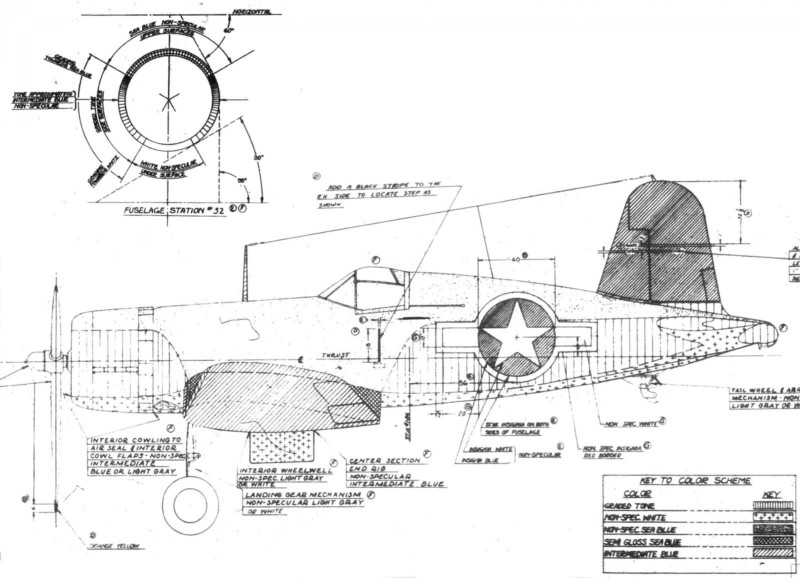









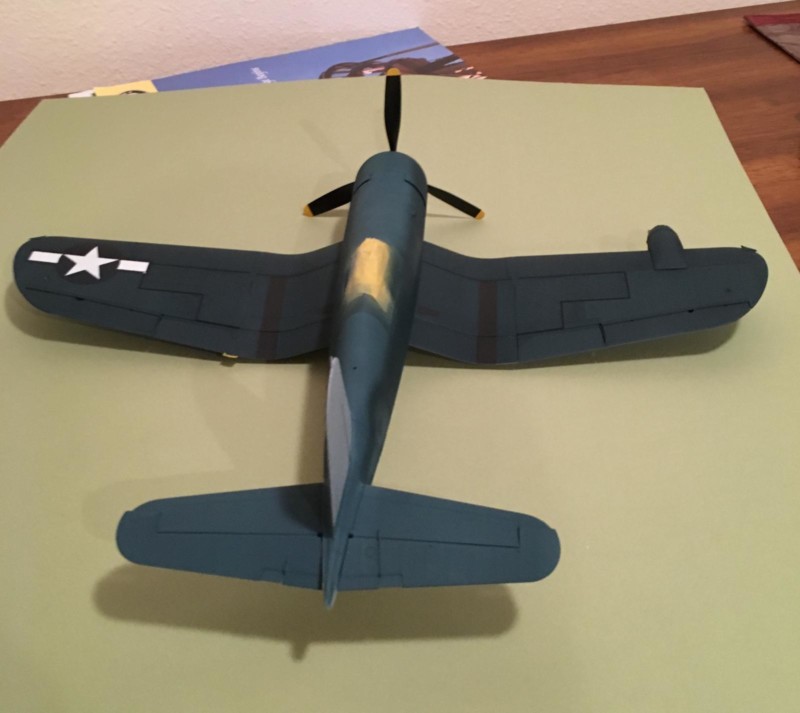


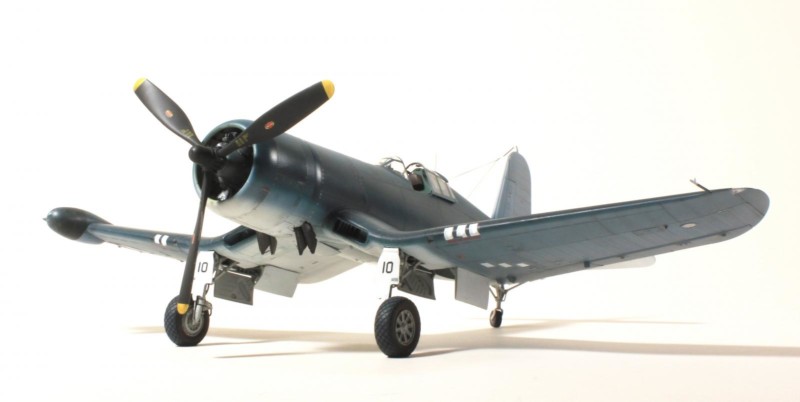
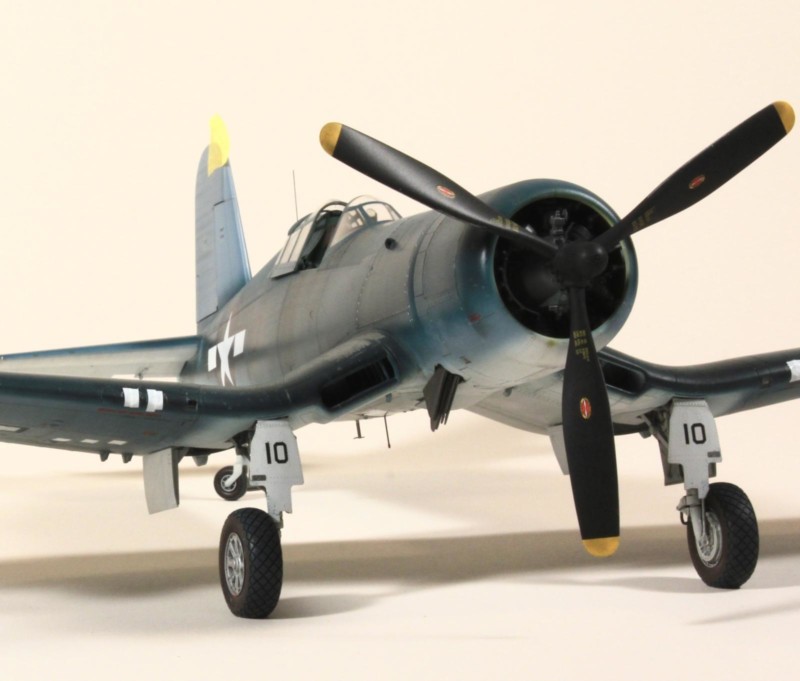








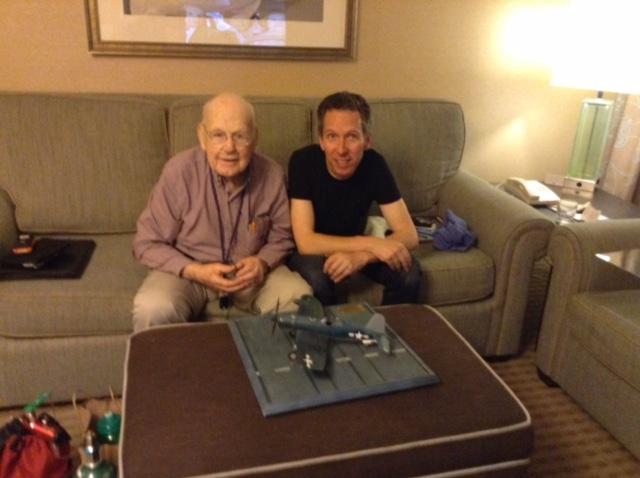


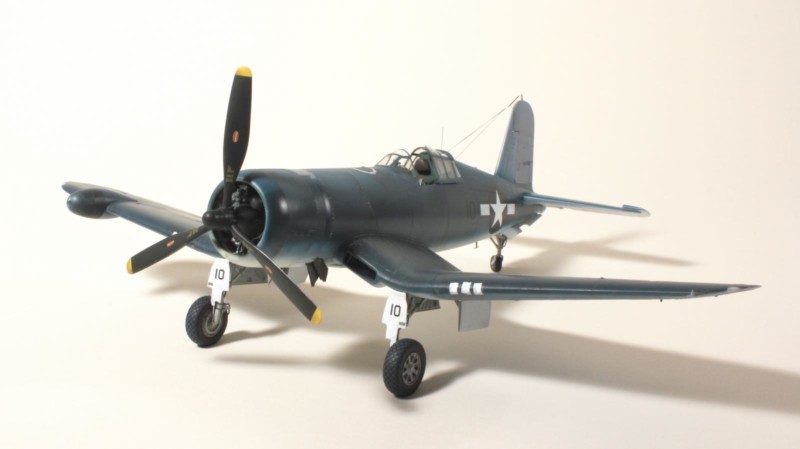
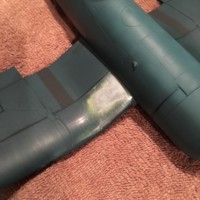




Excellent. Just excellent.
even better now that i finished the article. Sorry its so long.
Hello David...My congratulations on not only a most excellent build but also for your thoughtfulness in building that plane for Bob Brunson who by any yardstick of judgement is a true American hero. No doubt an outstanding gesture on your part. The model itself is very nicely done and very well researched. A job well done sir.
Not sure if you see the finished version yet. Hope i gave you adequate acknowledgement. This project could not have happened without you.
Couldn't agree more with what Jim said, David...a really nice piece of modeling right there. And an excellent "backstory" as well.
Thanks Craig
A beautiful Corsair, well-written article, and excellently motivated building project!
Dave, an excellent model and a great cause. It was fun having this project come and visit me at my home during it construction, I normally say at this point, " I'm glad it worked out", however knowing you and your determination on this project, their was no doubt in my mind that this was going to be a successful and rewarding undertaking. Well done !
Beautiful work and a great story.
I remember Chick Harmer saying how much VF(N)-101 was disliked until he was launched in bad weather to find some lost Big-E day flyers and bring them back to the ship. He also did the same thing on the Mission Beyond Darkness to bring planes home from the strike against the Mobile Fleet.
I'd say the recovery efforts during the Mission Beyond Darkness was the F4U-2s finest hour.
Great job, a very nice Corsair, and good job presenting the model to Bob. I believe should have been a great emotion for him.
Outstanding and so enjoyed the read thanks.
Excellent model and a touching tribute too. There was a time when giants walked this earth... Thanks for everything you've done with this project Dave!
Thanks for everything you've done with this project Dave!
Beautiful F4U David, and a great story to go with it. I'll bet spraying the variations in blue was challenging. Just as it was for Vought...
I really enjoyed this one. They "Bent Wing Bird" is my favorite all time plane. You are very fortunate to have met and been able to spend some time with Bob. They aren't called the "Greatest Generation" for nothing... Thank you. Hand Salute.
This is the second Corsair i've done in what i call the "Heavily Blended 4 Tone Scheme". The first one was done using Mr Color, and this one was done using Tamiya acrylics.
I think i made the switch from enamels to acrylics andlacquers just in time. Due to the nature of how the real plane was painted, and knowing how enamel paints work, i don't think i could have gotten the same results with enamels. The great thing about using acrylics or lacquers is that the final finish is very, very thin, and gloss colours like sea blue dry super fast, which speed up the build cycle. The disadvantage is you have to pay closer attention to surface prep (sanding scratches, etc.), and sometimes the paint peels off in itty bitty flakes with no apparent ryme or reason. I had this happen a lot while i was painting the national insignias, and going back with sanding, re-masking, and re-painting was pretty time consuming. Because the paints are so heavily thinned, it takes a while to build up the requisite coverage and opacity but i think in the end the results are worth it.
Outstanding story Dan, true to life, compelling and an honor. What better way to present an aircraft that was part of the war even without making a kill. It just tells the importance every single aviator and sailor meant to the Navy and America, not everyone will be an ace or much less bag a kill. But your still doing your job, being the best you can be. Thats what he did, it's what we still do. Thanks for an amazing story. You did good Dan not only for Bob but for every unsung pilot who flew.
Beautiful work... Great narrative!
David: This is an outstanding post; the background narrative (about Bob and the model building) is excellent. The pix really make this article, because they show all of us what a master builder you are. Thanks for posting this piece...Congratulations.
I consider myself good, not great.
A very special work of love, David. Time well-spent. Wonderful work.
Bob
Believe it or not, Bob Brunson sent me a birthday email today.
Amazing build David, spotted it just now but still wanted to tell you how I admire this masterpiece!
thanks!
Amazing work David.
I am your biggest fan after Bob Brunson.
Bob sent me his homemade book last year.
Tom Harmer told me he still reads my blog about VF(N)-101.
Thanks Pierre!
I was puzzled as to why you re-posted my F4F pictures, but after reading your blog post this morning, it all becomes clear now.
Beautiful work. In every respect.
'Liked'